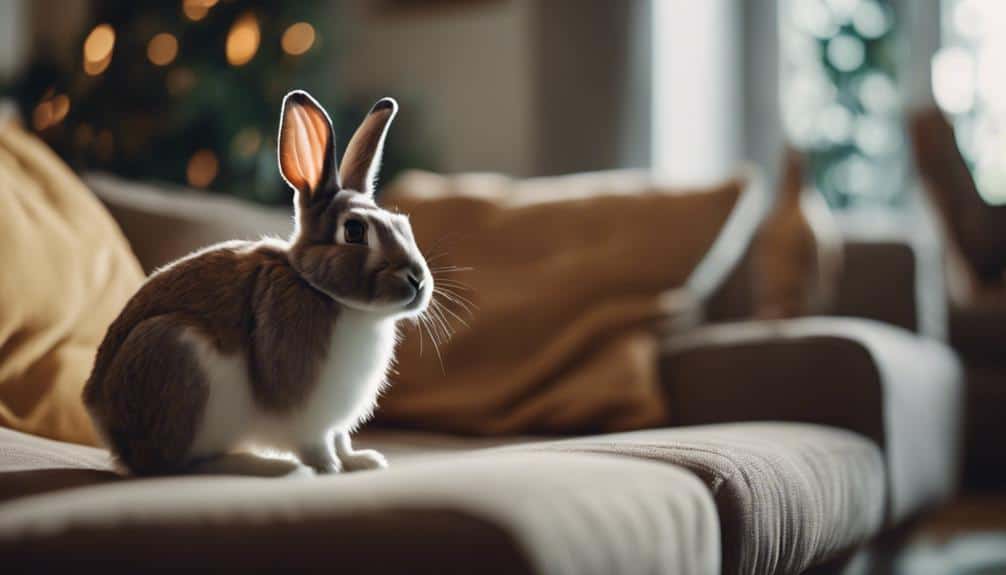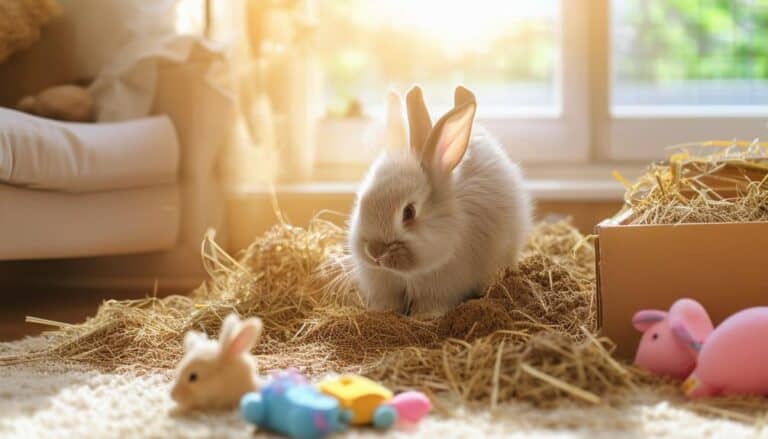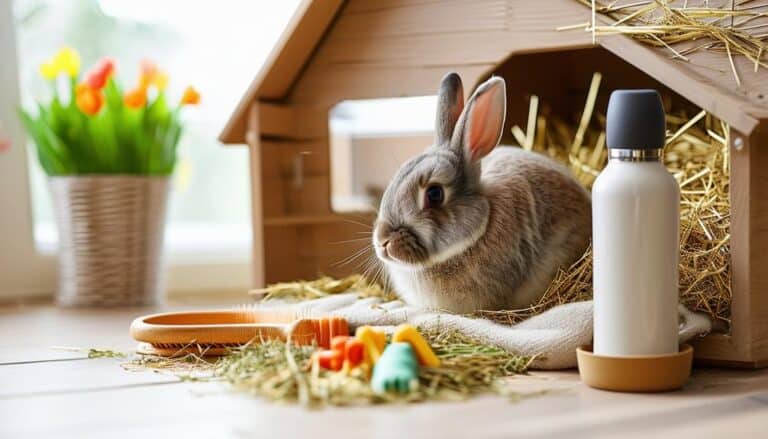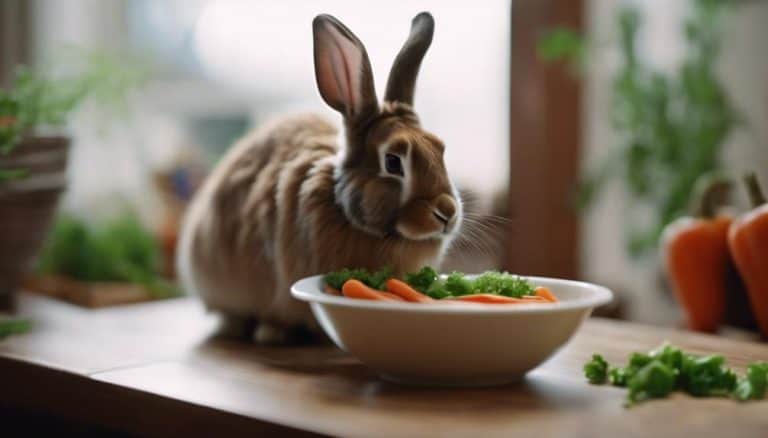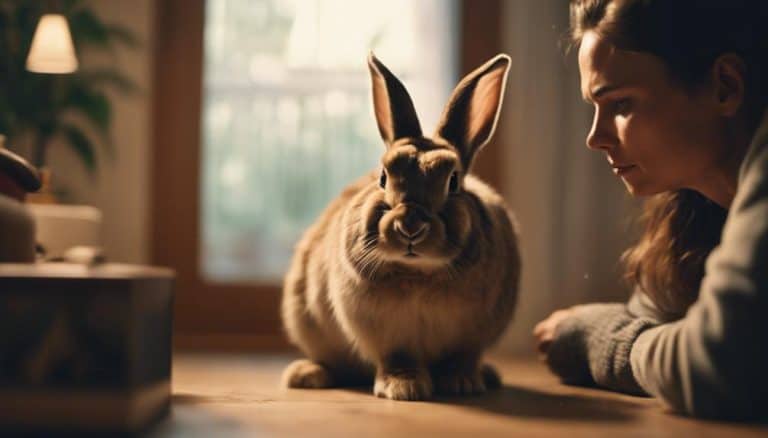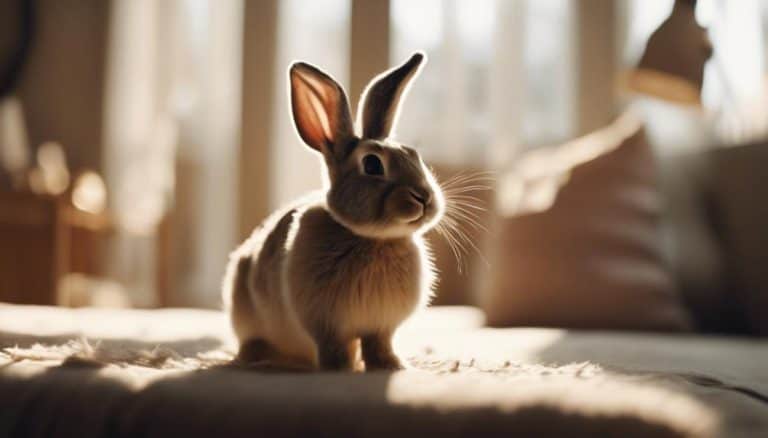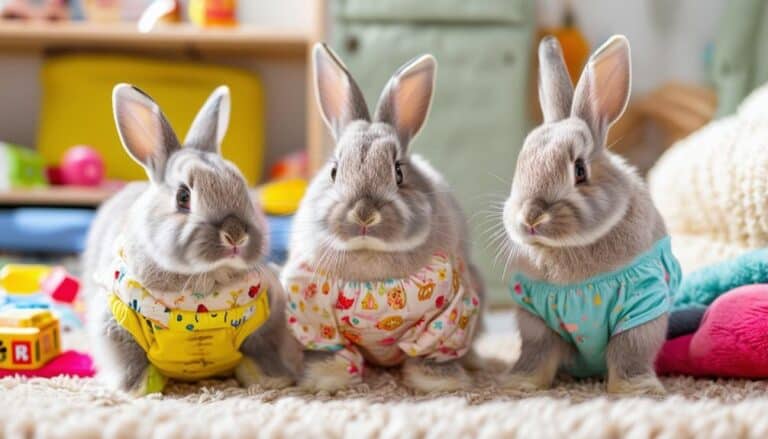How to Decode Pet Rabbit Noises
Understanding the various noises your pet rabbit makes is vital for ensuring their well-being and happiness. You might hear grunts, honks, or even screams, each indicating different emotions or needs. For instance, grunting often signals anger or stress, while honking can mean excitement or affection.
But what about those less common sounds like teeth grinding or thumping? Each noise has its own significance and learning to decode them can make a world of difference in your pet’s life. Curious about what your rabbit is trying to tell you? Let’s explore these fascinating sounds further.
Grunting
A rabbit’s grunting is a clear indicator of anger or stress, often signaling their displeasure or discomfort. When you hear your rabbit grunting, it’s important to understand that this vocalization serves as a sign of anger and stress. This higher-pitched noise compared to growling can be used to scare off perceived threats or assert dominance. Recognizing these sounds is vital for maintaining a harmonious environment for your pet.
When your rabbit grunts, it’s their way of communicating that something is amiss. Whether they feel threatened or are simply asserting their territory, grunting indicates a need for immediate attention. Ignoring this sign of displeasure can lead to increased stress for your rabbit.
To address this, observe the context in which the grunting occurs. Are there new elements in their environment causing stress? Has their routine been disrupted? Identifying these factors can help you mitigate the stressors.
Most importantly, give your rabbit space when they start grunting. This allows them to calm down and feel secure again. Understanding and addressing the reasons behind rabbit grunting can greatly improve their well-being and ensure a stress-free, comfortable habitat for them.
Honking
When your rabbit honks, it’s often a sign of affection or a way to seek attention. This vocalization typically indicates that your pet is happy and enthusiastic to interact.
Recognizing honking can help you understand your rabbit’s emotional state and respond appropriately.
Sign of Affection
In rabbits, honking is a distinctive vocalization that signifies excitement and happiness. This happy noise is a clear sign of affection, often heard when your rabbit is anticipating a treat or feeling particularly joyful. Understanding honking in your pet can help you recognize these moments of contentment and excitement, strengthening your bond.
Rabbit noises like honking aren’t just random sounds; they’re meaningful expressions. When your rabbit honks, it’s showing a sense of delight and pleasure. This behavior is a direct indicator that your rabbit feels safe and happy in its environment. Knowing these signs of affection allows you to respond appropriately, reinforcing their positive feelings.
Pay close attention to the context in which your rabbit honks. You might notice this sound during playtime or when you approach with a favorite snack. Each honk is a small but powerful signal of your rabbit’s well-being and comfort around you.
Seeking Attention
Rabbits often use honking as a means to seek attention from their owners. This distinctive sound is an expression of excitement or happiness, typically occurring when your rabbit anticipates treats or enjoyable activities. Honking is a clear indicator that your rabbit is feeling joyful and enthusiastic, making it an essential sound to recognize for effective communication.
When you hear your rabbit honking, it’s important to respond appropriately. This vocalization signifies that your rabbit is keen for interaction and enjoyment. Whether it’s expecting a favorite treat or looking forward to playtime, honking is a direct way for your rabbit to express positive emotions and seek your attention.
Understanding these sounds can greatly enhance your bond with your rabbit. Knowing that honking is a sign of happiness helps you cater to their needs and create a more enriching environment. Pay close attention to the context in which the honking occurs, as it can provide insights into your rabbit’s preferences and desires.
Screaming
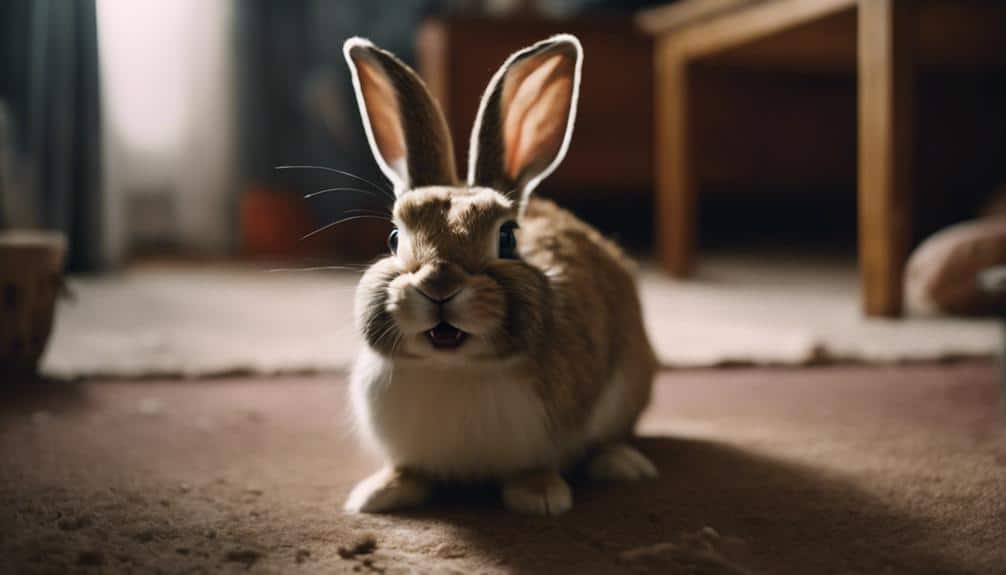
When your rabbit screams, it’s a clear sign of extreme fear or intense pain that demands your immediate attention.
Identifying the causes of this distress and recognizing other distress signals are essential steps in addressing the issue promptly.
If the screaming persists or your rabbit continues to show signs of distress, seek veterinary care without delay.
Causes of Rabbit Screaming
A rabbit’s scream is an alarming, high-pitched sound that signifies extreme fear, distress, or intense pain. Rabbit screaming isn’t a common occurrence, and when it happens, it indicates that your pet is undergoing severe emotional or physical duress. Understanding the causes can help you provide immediate care and comfort to your rabbit.
One primary cause of rabbit screaming is extreme fear. This can be triggered by sudden threats, such as the presence of a predator or an unexpected loud noise. Rabbits are prey animals, and their instinctive response to danger can be very intense.
Another significant cause is distress due to physical pain. This could be from an injury, internal health issues, or after a traumatic event like a fall or accident.
If you hear your rabbit screaming, it’s important to act promptly. Check for visible injuries and assess the environment for potential threats. Providing a calm, secure space can help alleviate immediate fear.
If the screaming persists or if you notice signs of continued pain or fear, seek veterinary assistance promptly. Addressing the root cause is essential to safeguard your rabbit’s well-being and prevent further distress.
Identifying Distress Signals
Understanding the causes of rabbit screaming is only the first step; identifying the specific distress signals can further aid in providing timely and effective care. When a rabbit screams, it’s a clear indication of extreme fear or pain. You need to be vigilant for other signs of distress that often accompany screaming, such as teeth grinding and visible signs of pain. Teeth grinding in rabbits can signal discomfort or severe pain. If your rabbit is grinding its teeth while screaming, it’s likely experiencing extreme pain and requires immediate attention.
Rabbits may also scream when they sense danger. This reaction could be triggered by a predator or a sudden environmental change. Observing the context in which the screaming occurs can help you determine whether the rabbit is reacting to a painful condition or a perceived threat. Don’t ignore these distress signals; they’re vital indicators that your rabbit needs help.
To safeguard your rabbit’s well-being, comfort it immediately and observe its behavior closely. If the screaming persists or your rabbit remains frightened, consult a veterinarian without delay. Quick intervention can make a significant difference in addressing the root cause of your rabbit’s distress.
Addressing Immediate Concerns
You must act swiftly to address the immediate concerns when your rabbit starts screaming, as this indicates severe distress or fear. A rabbit scream is an unmistakable sign of extreme fear or pain and requires your urgent attention. Immediate comfort is your first priority to help soothe your frightened pet.
Here are steps to take when you hear a rabbit scream:
- Approach calmly: Move toward your rabbit slowly and speak in a soft, reassuring voice to avoid exacerbating the fear.
- Physical comfort: Gently pick up your rabbit, ensuring they feel secure and supported. Hold them close to your body to provide warmth and security.
- Check for injuries: Look for any signs of physical harm. A rabbit may scream if they’re in severe pain from an injury.
- Remove stressors: Identify and eliminate any immediate threats or stressors in the environment that may have triggered the extreme fear.
- Consult a vet: If your rabbit continues to scream or remains visibly distressed, consult a vet immediately for further evaluation and professional care.
Understanding the context and potential triggers behind a rabbit scream can help you provide the necessary immediate comfort and safeguard your pet’s well-being.
Teeth Grinding
When your rabbit grinds its teeth, the sound can indicate either contentment or significant pain, requiring careful observation to interpret correctly. The context and importance of the grinding are critical. Soft tooth purring, a quieter grinding sound, usually signifies that your rabbit is relaxed and happy. However, loud teeth grinding, often a sign of pain or stress, should never be ignored and demands immediate veterinary attention.
Teeth grinding in rabbits can be perplexing, but understanding the differences can help you gauge their well-being. Here’s a quick reference table to help you differentiate:
| Grinding Type | Sound Level | Possible Indication |
|---|---|---|
| Soft Tooth Purring | Low, gentle | Contentment, relaxation |
| Loud Grinding | High, harsh | Pain, distress |
| Rhythmic Grinding | Moderate, steady | Comfort, grooming |
| Erratic Grinding | Irregular, sharp | Acute discomfort, anxiety |
Rabbits may grind their teeth when they are comfortable, similar to how cats purr. Yet, when this sound escalates to a louder, more abrasive noise, it’s often a distress signal. Monitoring the context and importance of these sounds will provide valuable insights into your rabbit’s emotional and physical state.
Thumping
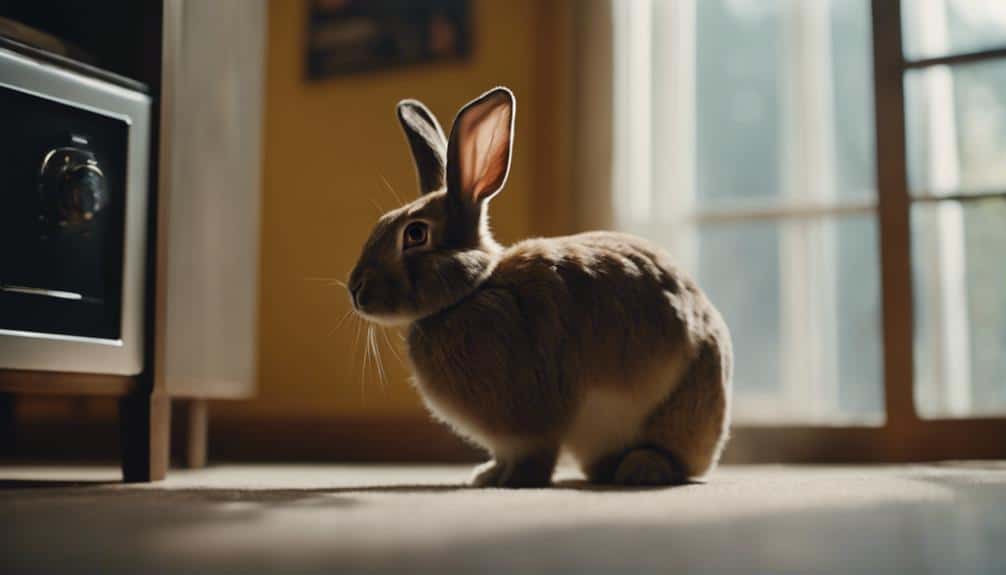
After recognizing the nuances of teeth grinding, another significant rabbit behavior to understand is thumping. This loud noise, produced by rabbits striking their hind legs against the ground, serves as an important form of communication. It can indicate various states such as stress, fear, or discomfort. By paying attention to the context in which thumping occurs, you can better address your rabbit’s needs and safeguard their well-being.
Thumping isn’t just a random act; it has specific implications:
- Warning Signal: Rabbits often thump to alert others of perceived danger.
- Expression of Annoyance: Sometimes, thumping is a way for rabbits to show they’re irritated.
- Stress Indicator: If your rabbit is thumping, they might be experiencing stress or fear.
- Territorial Behavior: Thumping can also be a method to establish dominance or mark territory.
- Communication Tool: It’s a way for rabbits to communicate with other rabbits in the environment.
Understanding these facets of thumping can help you create a more comfortable and secure environment for your pet rabbit. Recognize and respect their communication, and you’ll build a stronger, more trusting relationship with your furry friend.
Clucking
Clucking, a unique vocalization made by rabbits, signifies contentment and satisfaction. Unlike the clucking of chickens, this sound is quieter and lower-pitched. When you hear your rabbit make this noise, it usually means they’re relaxed, happy, or enjoying their favorite treats. This subtle sound can be easily missed, so paying close attention is vital to understanding your rabbit’s emotional state.
Recognizing when your rabbit makes clucking sounds can provide valuable insights into their well-being. A content rabbit often clucks while munching on vegetables or snuggling in a comfortable spot. This behavior indicates that your rabbit feels safe and secure in their environment. Monitoring these vocalizations helps you gauge their mood and ensure you’re providing the proper care and attention they need.
It’s essential to create an environment where your rabbit feels free and unrestrained, as this promotes positive behaviors like clucking. When you understand the significance of clucking, you can make more informed decisions about their habitat, diet, and overall care.
Making sure your rabbit’s happiness and satisfaction connects you more deeply with your pet and enhances their quality of life.
Growling and Hissing
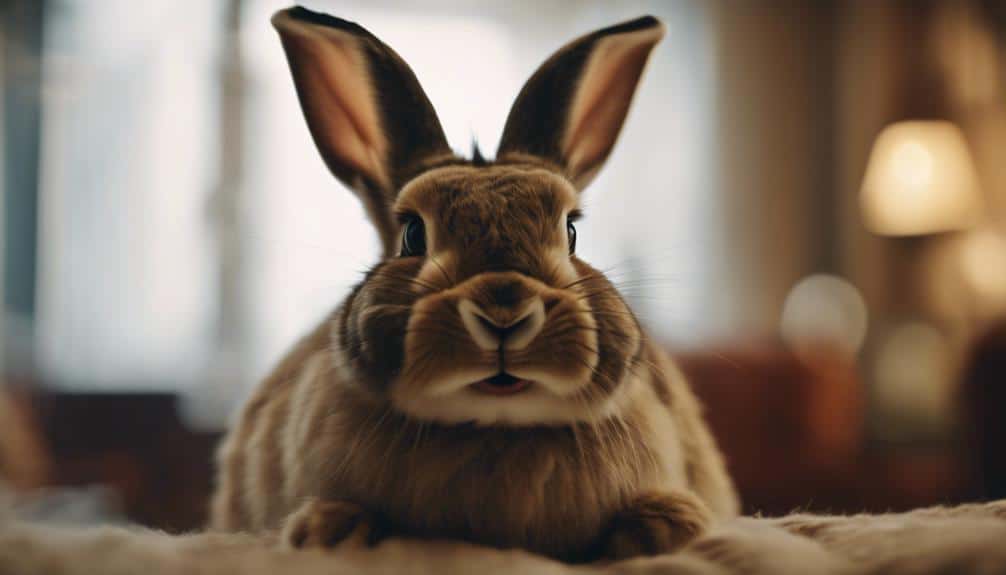
Growling and hissing in rabbits are clear indicators of aggression and discomfort, often signaling a need for space. When a rabbit growls or hisses, it’s letting you know that it’s angry or feels threatened. As a rabbit owner, respecting these signals is essential for maintaining a peaceful and trusting relationship with your pet.
Understanding why your rabbit growls or hisses can help you address the underlying issues. These sounds are often made to protect territory or express a desire to be left alone. Here are some key points to keep in mind:
- Territorial Behavior: Your rabbit might growl or hiss to defend its space, especially if it feels another animal or human is encroaching.
- Disapproval: Sometimes, growling and hissing indicate that your rabbit disapproves of your actions, such as touching or moving it.
- Fear and Threat: These noises can also signify fear, warning you to back off.
- Persistent Aggression: If the growling and hissing persist, consulting a veterinarian or behavior specialist is advisable.
- Body Language: Pay close attention to your rabbit’s body language to better understand its mood and needs.
Whining
When your rabbit starts whining, it’s important to observe the context to understand whether it’s expressing curiosity, annoyance, or a need for attention. Whining in rabbits can be a multifaceted vocalization that requires a keen eye and ear to interpret accurately.
Paying attention to the situation in which the whining occurs is essential. Is your rabbit whining while exploring a new environment? This may indicate curiosity. Conversely, if the whining happens during grooming or handling, it could signify annoyance or discomfort.
To accurately understand your rabbit’s whining, consider their body language. Are their ears laid back or twitching? Is there any sign of agitation, such as thumping or restless movements? These physical cues can offer vital insights into your rabbit’s emotional state.
For instance, a rabbit whining with a relaxed posture might be seeking attention or interaction. On the other hand, a tense body paired with whining often signals displeasure or distress.
Wheezing
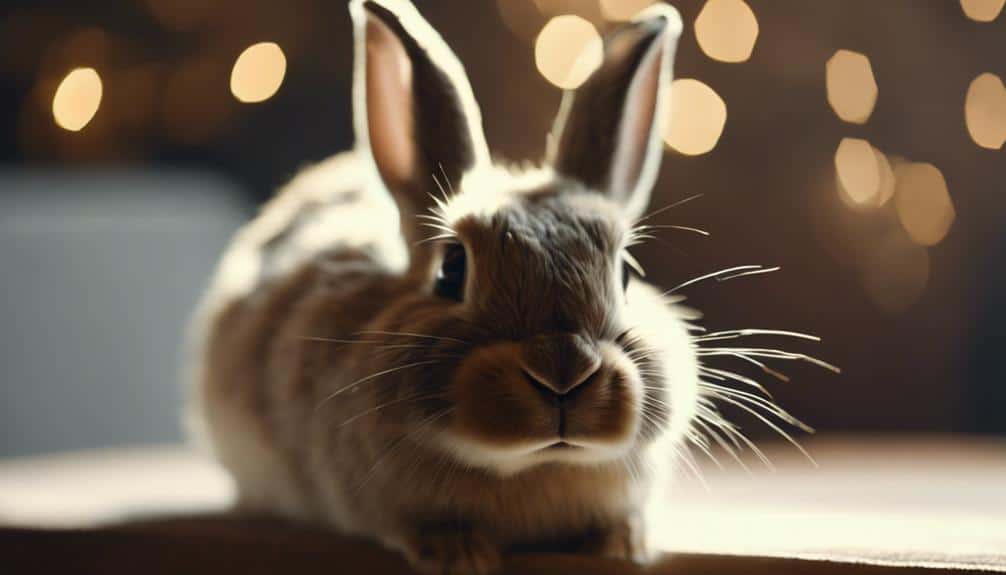
While understanding different vocalizations like whining can help you gauge your rabbit’s emotional state, wheezing is a serious indicator of potential respiratory issues that demands immediate attention. Wheezing in rabbits can signal respiratory problems such as infections or allergies. You need to listen carefully to any wheezing sounds, as they may be continuous and present during both inhalation and exhalation.
When you hear your rabbit wheezing, it’s vital to act promptly. Persistent wheezing suggests a more severe health condition that requires a veterinarian’s intervention. Here’s what you should do:
- Monitor for other symptoms: Look for nasal discharge, lethargy, or changes in appetite.
- Maintain a clean environment: Dust and allergens can exacerbate respiratory issues.
- Check for stress factors: Rabbits can wheeze when stressed, so reduce potential stressors.
- Ensure proper ventilation: Poor air quality can contribute to respiratory problems.
- Schedule a vet visit: A thorough examination is essential for accurate diagnosis and treatment.
Taking these steps will help safeguard your rabbit’s well-being. Remember, swift Rabbit Care actions can make a significant difference. If wheezing persists, don’t delay—take your rabbit to the vet immediately.
Conclusion
By keenly observing your rabbit’s noises and accompanying behaviors, you can better understand their emotions and needs. Recognizing grunts, honks, screams, teeth grinding, and other sounds will help you respond appropriately, ensuring your pet’s well-being.
Your attentiveness to these cues fosters a happier, healthier relationship with your rabbit. Remember, your proactive care and understanding directly contribute to their comfort and safety.
Always consult a veterinarian if you’re unsure about any behavior or sound.

